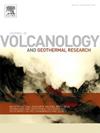非喷发瞬态和流体流动过程驱动火山构造危机,意大利
IF 2.3
3区 地球科学
Q2 GEOSCIENCES, MULTIDISCIPLINARY
Journal of Volcanology and Geothermal Research
Pub Date : 2025-07-31
DOI:10.1016/j.jvolgeores.2025.108410
引用次数: 0
摘要
虽然不是所有的火山动荡都会导致火山爆发,但人们普遍认为,岩浆从浅层地壳中上升会推动火山觉醒。当火山没有喷发时,热液活动通常被认为是造成膨胀和收缩过程的原因。然而,一个解释长期非爆发性动荡的因果过程仍然缺失。火山岛是意大利伊奥利亚火山群岛最南端的岛屿,于2021年9月陷入动荡。该岛经历了强烈的地面变形,火山喷发温度持续上升,气体排放和浅层地震活动。La Fossa cone山麓的CO2弥漫性土壤脱气增加,导致居民撤离。自2005年部署宽带网络以来,在地震记录中首次发现了日频率高达450次的甚长周期(VLP)地震事件。事后看来,2018年的地震记录中还发现了隐藏的新VLPs。大地测量数据显示,2021年发生了通货膨胀,这表明火山下方岩浆管道系统的浅层部分出现了加压。2018年也发生了类似的行为。然而,这些动荡的一些方面与传统的因果模型不完全兼容,这些模型援引了浅堤就位或热液情景。特别是,在2021 - 2022年期间,VLPs的长时间瞬态特征在热液驱动的动荡中从未遇到过。我们认为,深部流体压力可能是由岩浆或构造不稳定事件引起的,可能驱动了这些动荡,并导致了管道系统中静岩流体压力的离散和短暂释放。特别是,高分辨率节点环境噪声断层扫描显示的ne向正断层似乎在调节2021年动荡的瞬态特征中发挥了关键作用。一旦释放,超压锋面穿过流变复杂的区域,导致VLPs。一旦进入热液系统,流体(例如H2O和CO2占主导的混合物)就会相分离并膨胀。这给浅层管道系统加压,导致强烈的浅层微震活动。我们的模型得到了VLP事件在群体中发生的长期瞬态特征的支持,并协调了影响我们如何理解构造,火山作用和自然灾害之间相互作用的多个跨学科观察。本文章由计算机程序翻译,如有差异,请以英文原文为准。
Non-eruptive transients and fluid flow processes driving volcano-tectonic crises at Vulcano, Italy
Although not all volcanic unrests lead to eruptions, it is commonly believed that magma rising through the shallow crust drives volcanic awakening. When eruptions do not occur, hydrothermal activity is often claimed to be responsible for inflation and deflation processes. Yet, a causal process explaining long-lasting non-eruptive unrest is still missing. Vulcano, the southernmost island of the Aeolian volcanic archipelago, Italy, entered in unrest in September 2021. The island experienced intense ground deformation, a sustained increase in fumarole temperatures, gas emissions, and shallow seismicity. CO diffuse soil degassing increased at the foothill of La Fossa cone, causing the evacuation of inhabitants. Very Long Period (VLP) seismic events with a daily rate of up to 450 events/day were found in the seismic records for the first time since the deployment of the broadband network in 2005. With the benefit of hindsight, new VLPs were also discovered hidden in the 2018 seismic records. Geodetic data show inflation occurring in 2021, suggesting the pressurization of the shallow portion of the magmatic plumbing system beneath Vulcano. A similar behaviour occurred also in 2018. However, a few aspects of these unrests are not fully compatible with traditional causative models invoking a shallow dike emplacement or with a hydrothermal scenario. In particular, the long-lasting transient character of VLPs during 2021–22 has never been encountered before in hydrothermal-driven unrests.
We propose that deep-seated fluid pressure, possibly promoted by a destabilizing event at depth, either of magmatic or tectonic origin, may have driven the unrests and be responsible for a discrete and transient release of lithostatic fluid pressures from the plumbing system. In particular, NE-striking normal faults highlighted by a high-resolution nodal ambient noise tomography seem to play a key role in modulating the transient character of the 2021 unrest. Once released, overpressure fronts travel across a rheologically complex domain causing VLPs. Once entering the hydrothermal system, fluids (e.g. HO and CO dominated mixtures) phase-separate and expand. This pressurizes the shallow plumbing system leading to intense shallow microseismicity. Our model is supported by the long-lasting transient character of the VLP events occurring in swarms and reconciles multiple interdisciplinary observations impacting how we understand the interplay between tectonics, volcanism and natural hazards.
求助全文
通过发布文献求助,成功后即可免费获取论文全文。
去求助
来源期刊
CiteScore
5.90
自引率
13.80%
发文量
183
审稿时长
19.7 weeks
期刊介绍:
An international research journal with focus on volcanic and geothermal processes and their impact on the environment and society.
Submission of papers covering the following aspects of volcanology and geothermal research are encouraged:
(1) Geological aspects of volcanic systems: volcano stratigraphy, structure and tectonic influence; eruptive history; evolution of volcanic landforms; eruption style and progress; dispersal patterns of lava and ash; analysis of real-time eruption observations.
(2) Geochemical and petrological aspects of volcanic rocks: magma genesis and evolution; crystallization; volatile compositions, solubility, and degassing; volcanic petrography and textural analysis.
(3) Hydrology, geochemistry and measurement of volcanic and hydrothermal fluids: volcanic gas emissions; fumaroles and springs; crater lakes; hydrothermal mineralization.
(4) Geophysical aspects of volcanic systems: physical properties of volcanic rocks and magmas; heat flow studies; volcano seismology, geodesy and remote sensing.
(5) Computational modeling and experimental simulation of magmatic and hydrothermal processes: eruption dynamics; magma transport and storage; plume dynamics and ash dispersal; lava flow dynamics; hydrothermal fluid flow; thermodynamics of aqueous fluids and melts.
(6) Volcano hazard and risk research: hazard zonation methodology, development of forecasting tools; assessment techniques for vulnerability and impact.

 求助内容:
求助内容: 应助结果提醒方式:
应助结果提醒方式:


